
|   |

|   |
 e-mail: leelakaverivenkat@gmail.com Encouraging response to Aavartan Festival Photos: Vinay Tiwari September 25, 2024 Established in 2020 by Madhur Gupta, to spread classical art education amongst the youth, Sangeet Vidya Niketan's valiant effort has worked on the principle of Marg Darshan through a Guru going far beyond the formal instructions inside of the classroom. 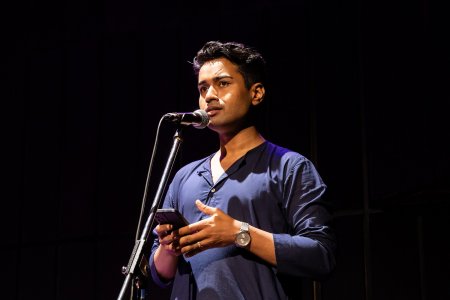 Madhur Gupta Its latest two day event Aavartan held at Stein auditorium of the Habitat, Delhi, not only provided recitals in both classical music and dance, but also blended in the same show, young talents along with the expertise of established artistes - demonstrating in the process, how Art survives through ages - by enriching on the one hand and in turn getting enriched. Above all making the two evenings ticketed events, for this critic, was a courageous and much needed step - especially for an art viewing community, which in the 'free for all' programs, seems to take for granted the dancer, who, living on air, has to provide programs! Aavartan at the foyer of Stein auditorium, along with its dance festival, held a very fine exhibition of dance photographs of Avinash Pasricha. It was a pleasure to go down memory lane as it were, looking at old photographs of present day very senior dancers. This documentation is so much a part of dance history that people often tend to forget it . One was already in a mood, even before entering the auditorium to find your seat. 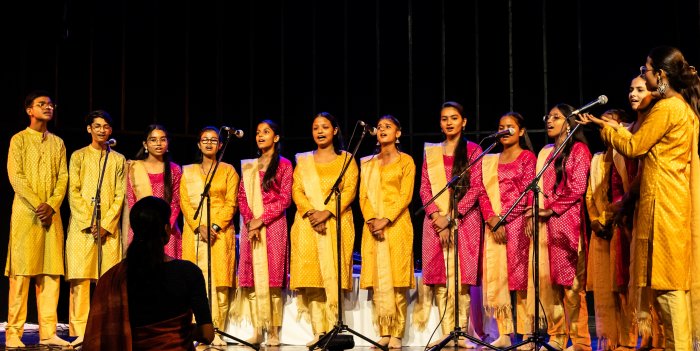 Delhi Children's Choir While this is not a column for discussing classical music except as a corollary to dance, it would be an omission not to mention the very disciplined rendition by the Delhi Children's Choir rendering bandishes in raag Yaman followed by raag Kedar and more importantly, the fact of the work of the same organization, in undertaking training of youngsters from government schools comprising students from marginalized backgrounds. Following this was a superb Hindustani classical recital on the sitar by Dhruv Bedi of the Imadkhani Gharana with Akram Khan on the tabla, the dulcet notes of Shudh Kalyan and the delightful rhythmic exchanges between sitar and tabla casting a spell over the audience. 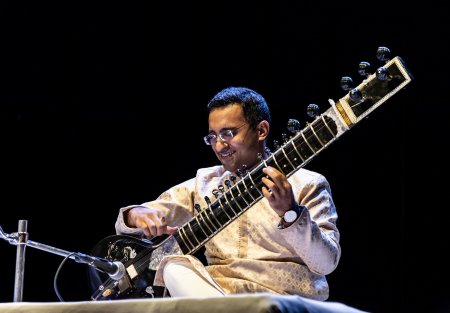 Dhruv Bedi Saswati Sen's Kathak recital was the crowning event of the first evening. After initial training under Reba Vidyarthi at the Delhi Kathak Kendra, Saswati Sen, premier disciple of late Guru Birju Maharaj, rose to be one of his most acclaimed shishyas, with the honour of the Guru's baton being passed over to her, with her heading Maharaji's institution Kalashram. More involved in teaching and in running errands for the Kathak school, Saswati's solo programs have been rare of late. Taking the floor, Saswati enthralled the audience with her expertise and creative imagination. She began with homage to the elephant headed God, on Ganesh Chaturthi day, portraying an image of the God as described in a composition by Maharaji, "Gajamukha vandana lage aise Sundara." Armed with ankusha and pasha, this lover of modaka, with his vahana the mooshika has one hand in the abhaya hasta. Tastefully turned out, and appearing nowhere close to her seniority, Saswati went on to the main theme of the evening her dance was built on - namely Pancha Tatwas or the five elements making up this Universe. And the greatness lay in the fact that the theme was illustrated not through the poetry of words, but of rhythmic syllables of nrtta, which, wielded by the expert, can and did speak stronger than words. Taking the message directly from her Guru, who spent a lifetime working on the endless possibilities that lie within the vocabulary of rhythmic syllables, in the texture of sound and verbal jugglery in the music it produces, in its placement in a composition - its entire world of abstraction lending itself to a whole range of meanings. 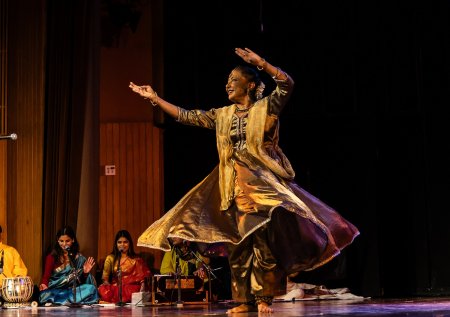 Saswati Sen In between the abstract world of sound through rhythmic syllables, Saswati also used slokas from the Shiva Puran, the Mahabharat and from the Upanishad. Teen taal Vilambit started the exposition with jal or water. Hands moving slowly in waves, with slow body turns with hands moving in undulating movements and curves suggesting water to sounds Dhigi, Digi... or Dhidhina Dhidhina in Thaat, slowly gave way to suggesting the expanse of the skies in Akash. This feel of the expanse of infinity, was shown through rhythmic syllables in varying patterns - together suggesting skies filled with stars, to scattered sounds suggesting stars unevenly placed. The echo of sound in emptiness was suggested through a Ginti Tihai, one of the most highly researched parts of Maharaji's work, with counts 1 to 8 at different speeds, staggered at different points, and after this came a Paran - Dha ta ka thunga ending in Gopuch fashion - wherein a bunch of rhythmic syllables working together end with a tapering off of sound, with syllables getting dropped one by one in every succeeding line, till none is left. All these subtly suggested the expanse of the skies, empty spaces and scattered stars with innumerable clusters of stars in groups, forming shapes tapering off into nothingness. Vayu or air is an element no living creature can live without. Announcing that everybody needs it, the dancer went into a short demonstration of Roopam against Pratiroopam in the form of Vishnu and his consort. Air never sleeps, moving gently or swiftly. Here Saswati used a sensitive Bhav Tihai, suggesting Vayu in different moods - soft and gentle or full of vigour. Tihai at gentle speed, moving up to a point before tapering off by dropping syllable after syllable was followed by Vayu in a swift manifestation suggested in the form of taal Dhamar. Taking the Mahadeva Shiva Shambho, the Sarvam Bhauma Bhoomi underlining the earth Prithvi, the planet on which life is seen in different forms, Saswati entered the arena of Gat Nikas, and what could be more telling of the creatures on Earth than the various Chals of Kathak - Gajagamini, Hamsagamini, Sarpa crawl, the leaping deer and when it comes to the human species, there is nothing to beat the various types of Nayikas or heroines - also representing different situations in love - with the heroine an inexperienced Mugdha, a Madhya or a Praudha well experienced in man/woman relationships. Finally to end this section on earth, Saswati gave a brief demonstration of the Thumri Mohe chedo na nand kunahu chhail in Basant Hindol, ending with the nayika pleading with waylaying Krishna that she be allowed to go, for it is a late hour - "Badi dher mohe janey do". Saswati has always been known for her subtle abhinaya prowess. Agni, the last of the elements dealt with, in the fury of its burning, is a perfect representation of speed contained in the drut laya with chakkars round the stage space and fast peir ka kaam. For a recital entirely relying on the bol, Saswati had Utpal Ghoshal on the tabla, Jayawardhan Dadhich for vocal support, Chandrachud Bhattacharya on sitar, Aniruddha Chowdhury on keyboard, and two students Himanshi and Garvita for parhant. 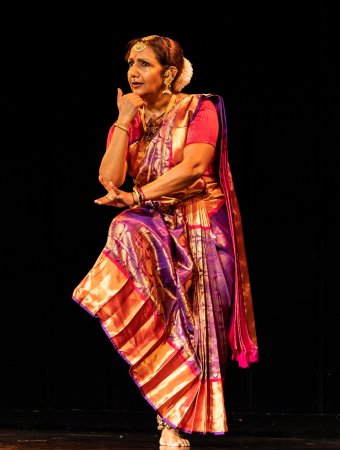 Kaushalya Reddy The next evening's relentless rains making the Gurgaon-Delhi road become an over three hour grind each way, forced one to miss watching a live show. Fortunately, a video of the other senior dancer, known lately, more for teaching and conducting shows than presenting a solo program, namely Kuchipudi dancer Kaushalya Reddy, was made available to enable this writeup. Sticking to the traditional format of Kuchipudi, with Raja Reddy leading the accompaniment with his nattuvangam, Kaushalya's musical support comprised Lavanya Sundaram the melodious vocalist, Manohar Balatchandirane on mridangam, V.S.K Annadorai on the violin, and Rajesh Prasanna on the flute. Starting with a sloka Ganesh Vandana, Om Sree Ganapataye Namah, in Ragamalika set to misrachapu talam, Kaushalya highlighted the qualities of the elephant headed God as the composition expresses - Sumukhaya, Ekadantaya, Kapilaya, Gajakarnakaya, Lambodharaya, Vikataya, Ganadhipaya, Vakratundaya etc before going on to a Muthuswamy Dikshitar kriti in raga Gaula, Sri Maha Ganapati Ravatuma, which aside from the prayer to Siddhi Vinayaka, is performed at two speeds, slow and drut with a solfa syllabic passage pa ma ga ma ri ga ma....giving scope, after the sahitya passages portrayed through abhinaya, for some contrasting nritta punctuation too. Needless to say, for Kaushalya, the picture of confidence, neither one or the other held any problems. The central part of the Kuchipudi recital was Usha Parinayam, based on the dream sequence of Banasura's daughter Usha in her sleep, when prince Anirudha, grandson of Krishna, appears and embracing her, dances with her. Bowled over by the prince's comely appearance, Usha loses her heart to the dream prince. This ragamalika composition with all the rakti ragas the tradition has employed in its music, has Usha on waking up trying to understand the dream which seems like a true happening. 'Emi Mayamu' (What's this magic) she wonders. The recital wound up with Tarangam with the Kanaka manimaya noopura charana kamala bhuvanatha shaswata charana line expressed with the rhythmics executed with feet planted on the rim of the brass plate. Usually one has the mridangist leading with the dancer trying to emulate the rhythm while dancing on the plate. Here with a dancer so used to calling the shots, so to speak, with her nattuvangam role, Kaushalya first danced the rhythmic sequence, which the mridangist repeated on his instrument. After prayers to Krishna, Manita guna sheela, the performance concluded with the dancer executing the usual Kuchipudi graceful walk round the stage while exiting. All muscle to Sangeet Vidya Niketan in its future ventures.  Writing on the dance scene for the last forty years, Leela Venkataraman's incisive comments on performances of all dance forms, participation in dance discussions both in India and abroad, and as a regular contributor to Hindu Friday Review, journals like Sruti and Nartanam, makes her voice respected for its balanced critiquing. She is the author of several books like Indian Classical dance: Tradition in Transition, Classical Dance in India and Indian Classical dance: The Renaissance and Beyond. Post your comments Pl provide your name and email id along with your comment. All appropriate comments posted with name and email id in the blog will also be featured in the site. |